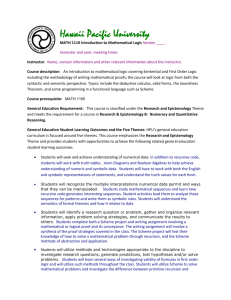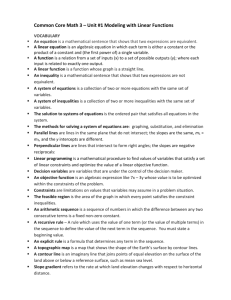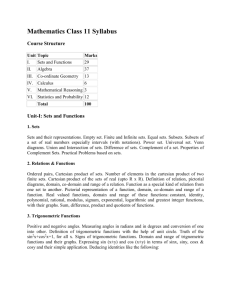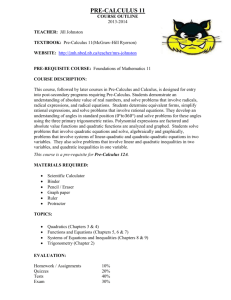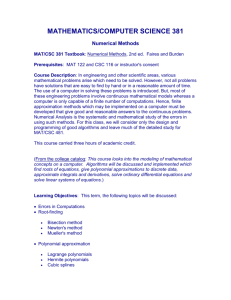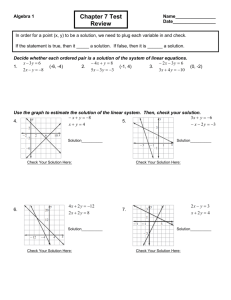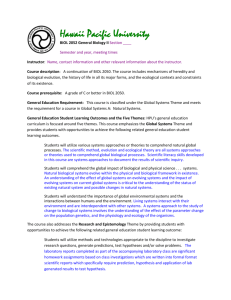Hawaii Pacific University
advertisement
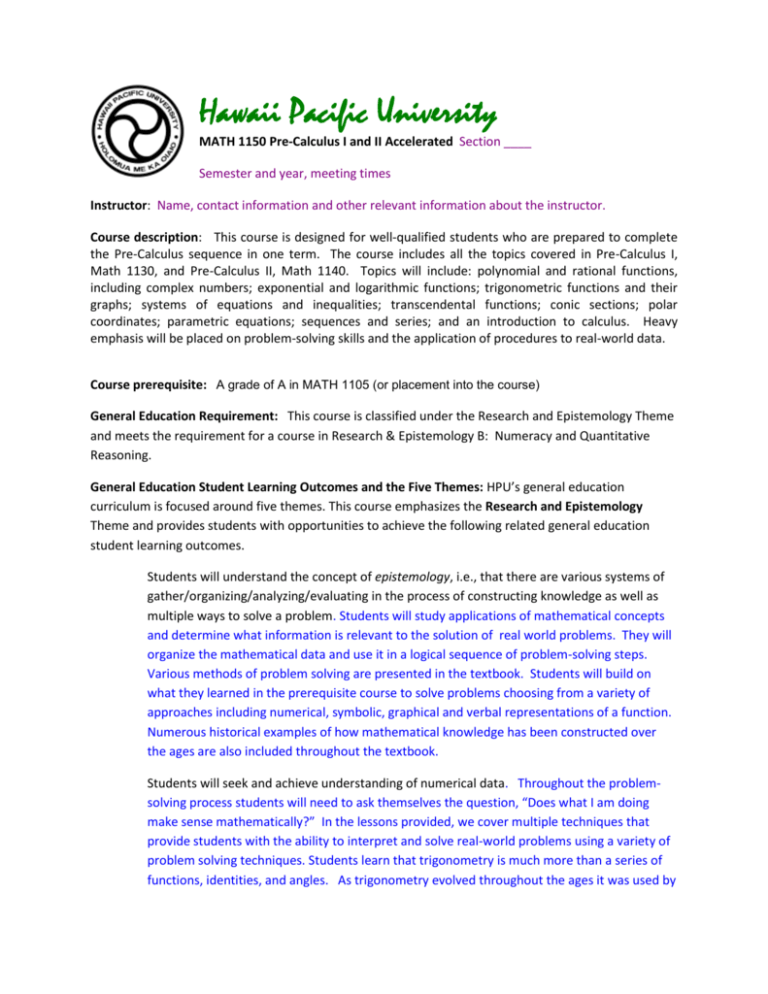
Hawaii Pacific University MATH 1150 Pre-Calculus I and II Accelerated Section ____ Semester and year, meeting times Instructor: Name, contact information and other relevant information about the instructor. Course description: This course is designed for well-qualified students who are prepared to complete the Pre-Calculus sequence in one term. The course includes all the topics covered in Pre-Calculus I, Math 1130, and Pre-Calculus II, Math 1140. Topics will include: polynomial and rational functions, including complex numbers; exponential and logarithmic functions; trigonometric functions and their graphs; systems of equations and inequalities; transcendental functions; conic sections; polar coordinates; parametric equations; sequences and series; and an introduction to calculus. Heavy emphasis will be placed on problem-solving skills and the application of procedures to real-world data. Course prerequisite: A grade of A in MATH 1105 (or placement into the course) General Education Requirement: This course is classified under the Research and Epistemology Theme and meets the requirement for a course in Research & Epistemology B: Numeracy and Quantitative Reasoning. General Education Student Learning Outcomes and the Five Themes: HPU’s general education curriculum is focused around five themes. This course emphasizes the Research and Epistemology Theme and provides students with opportunities to achieve the following related general education student learning outcomes. Students will understand the concept of epistemology, i.e., that there are various systems of gather/organizing/analyzing/evaluating in the process of constructing knowledge as well as multiple ways to solve a problem. Students will study applications of mathematical concepts and determine what information is relevant to the solution of real world problems. They will organize the mathematical data and use it in a logical sequence of problem-solving steps. Various methods of problem solving are presented in the textbook. Students will build on what they learned in the prerequisite course to solve problems choosing from a variety of approaches including numerical, symbolic, graphical and verbal representations of a function. Numerous historical examples of how mathematical knowledge has been constructed over the ages are also included throughout the textbook. Students will seek and achieve understanding of numerical data. Throughout the problemsolving process students will need to ask themselves the question, “Does what I am doing make sense mathematically?” In the lessons provided, we cover multiple techniques that provide students with the ability to interpret and solve real-world problems using a variety of problem solving techniques. Students learn that trigonometry is much more than a series of functions, identities, and angles. As trigonometry evolved throughout the ages it was used by surveyors, navigators and engineers. Present day applications extend to ocean tides, the rise and fall of food supplies in certain ecologies, brain wave patterns, and many other phenomena. Students will recognize the multiple interpretations numerical data permit and ways that they can be manipulated. This course will help students evaluate the validity of certain claims that have a numerical component. Students will have opportunities to estimate and calculate solutions to mathematical problems, and compare their answers with real-life data using textbook, library and Internet sources. Students will discuss different factors that may affect the outcome of mathematical problem solving, various methods for presenting numerical data, and the multiple interpretations numerical data permit. Students will utilize methods and technologies appropriate to the discipline to investigate research questions, generate predictions, test hypotheses and/or solve problems. In the lessons provided, problem-solving techniques are presented that employ the use of a graphing calculator. Calculators are utilized to investigate the many ways of presenting a problem and to explore different solution methodologies. Students will use verbal (written or oral), numerical (data table), symbolic (mathematical formula), and graphical representations of functions to solve problems. Students will further develop their mathematical and analytical skills to investigate numerical data, generate predictions, test hypotheses and/or solve problems. One such project involves fractals and finance—where fractal curves are used to analyze the stock market. In another example, students will use analytic geometry to determine the aphelion (greatest distance) and perihelion (shortest distance) between the Sun and a planet, and use this information to find the point of intersection of two planet orbits, and predict if they think the planets will ever collide. Note: Purple text shows places where specific course information must be filled in. Red text contains explanatory notes to the instructor which should be deleted before using the syllabus. Blue explanations above should be rephrased by the individual instructor if necessary to reflect the specific approach in that section of the course. Course specific outcomes below are an example and may also be rephrased or modified by the instructor. Student Learning Outcomes for MATH 1150 Pre-Calculus I and II Accelerated Upon the successful completion of this course, students should be able to: 1. Solve problems using equations and inequalities. 2. Create and utilize linear functions from real-world data sources. 3. Apply quadratic equations and inequalities to problem solving. 4. Utilize polynomial and rational functions. 5. Recognize and solve problems involving exponential and log functions. 6. Understand the basic properties of trigonometric functions and their applications. 7. Solve problems using trigonometric equations and inequalities. 8. Apply parametric equations and inequalities to problem solving. 9. Utilize polar coordinates and vectors in problem solving. 10. Solve linear systems of equations and inequalities using various methods. For the rest of these required syllabus items see the details in the faculty handbook. Delete this note once the syllabus is complete. For online courses there are some additional requirements given at this link. Texts List textbooks with ISBN’s and include this language as well All textbook information (pricing, ISBN #, and e-books) for this course can be found on the HPU Bookstore website: hpu.edu/bookstore. If you have any questions regarding textbooks, please contact the HPU Bookstore at: Phone: 808-544-9347 Or e-mail: jyokota@hpu.edu mmiyahira@hpu.edu Assignments and mode of evaluation Summary of important dates and deadlines (if the schedule is a separate document and due dates are not given with the description of the assignments). Class rules and policies (including regarding attendance, late work and academic dishonesty) Schedule of events (may be attached separately)

